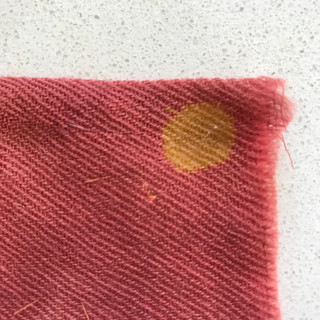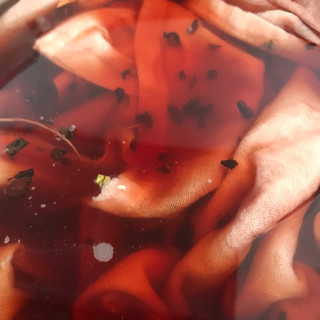In the previous post I showed dyeing with alder buckthorn (aka glossy buckthorn, rhamnus frangula, rhamnus alnus) on mainly protein fibres such as merino wool and handwoven silk.
In this post I will show the dye process with exact amounts and on cellulose fabrics.
None of the textiles were mordanted, but all were washed with soda ash for a light scour before.

I have been a bit perplexed, this dye does not appear in any of the old dye books I have, Berthollet, Parnell and Bancroft do not mention it. Why? It's an easy dye, it should be quite light fast because of the anthraquinone, it was certainly known in old civilisations, it's cheaper than logwood and abundantly available, so why this is not being discussed in the 17th and 18th century books I do not understand. There is one reference to a dye book from the 18th century, by Carl Linnaeus, a booklet about dye plants used in Gotland and Öland, Förtekning, af de färgegräs, som brukas på Gotland ock Öland, III (1742) but it's in Swedish and I have not found any translation of it yet.
For this dye project I used the following proportions;
25% WOF Alder buckthorn + soda ash (Enough to create a Ph 11)
100% WOF Alder buckthorn + soda ash (Enough to create a Ph 11)
50% WOF Alder buckthorn + 1 splash of acetic acid (vinegar) to get the Ph lower to a Ph5. My normal tap water is a Ph7.
Ph Sensitive
In a way the Rhamnus frangula behaves a lot like Himalayan rhubarb; does not need a mordant and is very sensitive to Ph. This is something you should consider when you are dyeing with natural dyes. Using a Ph sensitive dye in a garment where sweat could cause stains, is not a smart move. Dyes such as Rhamnus frangula, and Himalayan rhubarb that are very light fast but Ph sensitive would do well on pillow covers for a couch, or window panels or even on a scarf which is worn on top of other clothes.
Here you see the effect of pure vinegar on a sample of merino wool dyed with Rhamnus frangula.
Fabrics used in theses samples are;
Cotton tea towels.
I have no patience; I did not soak the bark before, I added water and the fabrics and started heating slowly, making sure the heat would not pass 60ºC. Kept at 60ºC for about an hour and let cool down in the dye pot. Soaking the bark at least an hour before, and leaving longer in the dye pot sure gives stronger hues, I can see that when I do new dye rounds in the exhaust which is even stronger than the original bath.
All the fabrics were immediately washed in Ph neutral Ecover and dried in the sun.
Two major tips; use gloves and use a bag to put your dye stuff in. My hands were totally disgusting and the floor was covered in bark after my little experiment.
The next step will be proper lightfastness testing for the Alder Buckthorn, to see what I can do using mordents such as tin and alum.
I am doing a whole set of tea towels for myself and this is what I have so far.
Cutch, Rhamnus Frangula, and indigo.






























